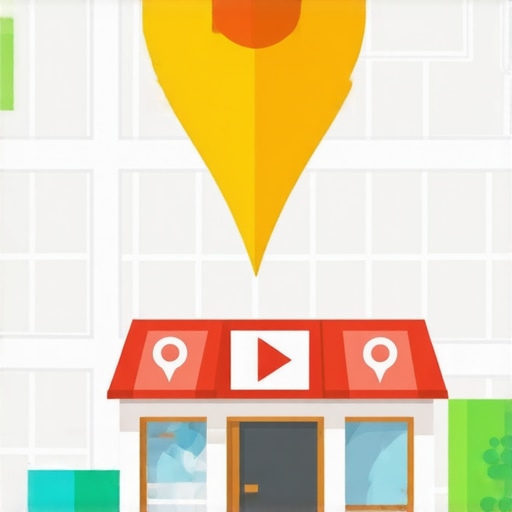My Journey to Google Maps 3 Pack Success: From Frustration to Triumph
Like many local business owners, I once struggled to get my business noticed on Google Maps. Despite investing time and effort, my GMB profile barely ranked, and I felt invisible to nearby customers. That’s when I decided to dive deep into proven strategies to improve my Google Maps 3 Pack visibility. Today, I want to share some personal insights that transformed my local SEO game and could help you too.
Why Is the Google Maps 3 Pack So Important for Local Business?
In my experience, ranking in the Google Maps 3 Pack is like having a prime storefront in the busiest part of town. It dramatically increases visibility, clicks, and ultimately, sales. According to Moz’s local search ranking factors, proximity, relevance, and prominence are key signals that Google uses to determine who makes it into that coveted top three. Understanding these factors was my first step towards success.
Expert Tips That Turned My Local Rankings Around
How Can I Optimize My Google Business Profile for Better Rankings?
Optimizing my Google Business Profile was a game-changer. I made sure all my information was accurate, complete, and enriched with relevant keywords naturally. I also added high-quality photos and encouraged satisfied customers to leave reviews—these are critical ranking factors. For a detailed step-by-step process, I recommend checking out the comprehensive optimization guide.
What Are the Best Local SEO Hacks to Accelerate My Rankings?
In my journey, I discovered that leveraging local citations and consistent NAP (Name, Address, Phone Number) data across directories significantly boosted my prominence. Additionally, engaging with Google posts and utilizing Q&A features kept my profile active and relevant. I also experimented with GMB citation services, which proved effective. For more advanced tactics, I often explore local SEO expert tips.
Can I Rely on Automation, or Do I Need Personal Touch?
While automation tools can help streamline certain tasks, I believe personal engagement is irreplaceable. Responding promptly to reviews and questions builds trust and signals activity to Google. I also learned that creating local content and participating in community events can enhance my profile’s relevance and authority. For a broader view, I suggest reading about GMB optimization secrets.
If you’re serious about dominating the local search results, I highly recommend exploring a dedicated Google Maps ranking strategy. And don’t hesitate to share your experiences in the comments—your tips might help others succeed too!
Mastering Local SEO: The Hidden Keys to Google Maps 3 Pack Domination
Achieving a top spot in the Google Maps 3 Pack isn’t just about basic optimization anymore; it requires a nuanced understanding of emerging trends and algorithm shifts. As local search becomes more competitive, savvy business owners are leveraging advanced techniques such as structured data markup, localized content, and strategic backlinking to enhance their visibility.
How Can Structured Data Markup Elevate Your Local SEO?
Implementing schema markup, especially LocalBusiness schema, helps search engines better understand your business details. This can lead to rich snippets, which attract more clicks and improve your rankings. Properly structured data can also enhance your appearance in local packs, especially when combined with high-quality reviews and accurate NAP information. For a comprehensive guide, check out this resource.
Is Content Localization the Next Big Thing in Google Maps Rankings?
Absolutely. Creating hyper-local content—such as blog posts about community events, local news, or neighborhood guides—not only boosts relevance but also encourages local backlinks and engagement. These signals are increasingly important as Google aims to serve the most contextually relevant results. Incorporating local keywords naturally into your website and GMB posts can also improve your prominence in local searches.
What Role Do Backlinks Play in Reinforcing Your Local Authority?
In the realm of local SEO, backlinks from reputable local sources—such as chambers of commerce, local newspapers, or community blogs—are invaluable. They serve as trust signals to Google, indicating your business’s authority and relevance within the community. Developing relationships with local influencers and participating in local sponsorships can generate these valuable backlinks. For additional strategies, explore top-ranking hacks from local SEO experts.

Visualize a business’s local profile with schema markup, local content, and backlinks boosting its Google Maps visibility in a competitive market.
Are You Keeping Up with Google’s Algorithm Evolution?
Google continually updates its local search algorithms, prioritizing user experience, relevance, and authority signals. Staying ahead requires ongoing optimization, monitoring your local pack rankings, and adapting your strategies accordingly. Tools like Google Search Console and local rank trackers can provide actionable insights to refine your approach.
If you’re eager to deepen your understanding, I highly recommend exploring the ultimate blueprint for Google Maps domination in 2025. And for practical support, feel free to reach out via our contact page. Share your experiences and questions in the comments—your insights could help others elevate their local game!
Over the years, my journey with Google Maps optimization has been a blend of trial, error, and continuous learning. One of the most valuable lessons I’ve learned is that local SEO isn’t static — it’s a dynamic landscape that demands adaptability and a nuanced understanding of emerging trends.
For instance, I remember initially focusing solely on NAP consistency and reviews. While those are still fundamental, I discovered that integrating structured data markup and creating hyper-local content exponentially increased my visibility. Implementing LocalBusiness schema helped search engines understand my offerings better, leading to richer snippets and higher placements. This shift in strategy was inspired by insights from comprehensive schema guides.
But what truly set apart my success was embracing the complexity of Google’s evolving algorithm. I found myself asking: How can I stay ahead when Google continually updates its criteria? The key, I realized, is ongoing monitoring and adaptation. Using tools like Google Search Console and local rank trackers, I kept a close eye on my rankings and adjusted my tactics accordingly. It’s a bit like tending a garden—constant care yields the best results. For those interested in mastering this, I highly recommend exploring the blueprint for 2025’s local SEO.
Another aspect I’ve found fascinating is the power of local backlinks from community sources. Building relationships with local influencers and participating in community events not only foster goodwill but also generate valuable backlinks. These backlinks serve as trust signals, reinforcing my authority in Google’s eyes. If you’re curious about effective backlink strategies, check out this detailed guide.
In my experience, automation tools can be helpful but should never replace genuine engagement. Responding to reviews, answering questions, and creating local content are activities that require a personal touch. They build trust and demonstrate activity, which Google interprets as relevance and authority. I’ve learned that combining automation with authentic local interactions creates a powerful synergy.
From my perspective, the most successful local businesses are those that view Google Maps optimization as a holistic, ongoing process. It’s about understanding your community, staying current with algorithm changes, and continuously refining your profile and content. My personal tip? Never underestimate the value of small, consistent efforts — they accumulate over time into impressive results.
If you’re eager to elevate your local SEO game, I invite you to explore these proven strategies. And I’d love to hear about your experiences—share your insights or questions in the comments below. Your story might just inspire someone else to unlock their Google Maps potential.
Harnessing the Power of Structured Data for Local SEO Mastery
One of the more sophisticated techniques I integrated into my SEO arsenal was implementing structured data markup, specifically LocalBusiness schema. This approach goes beyond basic optimization, allowing search engines to precisely understand my business details, which can lead to enhanced rich snippets and better visibility in local packs. I discovered that when combined with accurate NAP information and abundant positive reviews, schema markup significantly boosts Google’s comprehension of my offerings, often resulting in improved rankings. For those eager to elevate their local SEO game, exploring comprehensive guides like this resource can provide valuable technical insights.
Are Hyper-Local Content Strategies the Future of Google Maps Optimization?
From my perspective, hyper-local content creation is transforming the way businesses engage with their communities. By developing blog posts centered around local events, neighborhood highlights, or community news, I created a perception of relevance and authority that resonated with both users and Google. These efforts fostered local backlinks and increased engagement metrics, which are increasingly influential in ranking algorithms. Incorporating local keywords naturally into website content and Google My Business posts helped reinforce my prominence in targeted areas. For a detailed strategy, I recommend reviewing this guide.
How Do Backlinks from Local Influencers Reinforce Your Authority?
Building relationships with local influencers, sponsorships, and participating in community events proved to be game-changing. These activities generated high-quality backlinks from reputable local sources such as newspapers and community blogs, which served as trust signals to Google. Over time, these backlinks elevated my profile’s authority, making it more likely to appear in the coveted top spots. I learned that authenticity and consistency matter more than sheer volume—genuine engagement builds sustainable authority. For actionable backlink strategies, I suggest exploring this detailed guide.
What Are the Nuances of Monitoring and Adapting to Google’s Algorithm Shifts?
Staying ahead in local SEO requires diligent monitoring of your rankings and algorithm updates. I relied heavily on tools like Google Search Console and local rank trackers to identify fluctuations and emerging trends. Recognizing patterns enabled me to adapt my strategies proactively, whether that meant updating schema markup, refreshing content, or engaging more actively with reviews. It’s akin to tending a delicate ecosystem—consistent care and quick adjustments yield sustained success. For a comprehensive understanding, I recommend exploring this ultimate blueprint.
Join My Deep Dive into Advanced Local SEO Techniques
If you’re serious about mastering Google Maps 3 Pack domination, I encourage you to explore these advanced strategies. Sharing experiences and insights in the comments can foster a community of learning, where practical tips evolve into powerful results. Remember, the journey to local SEO excellence isn’t purely technical—it’s about building trust, relevance, and authority through continuous innovation and genuine engagement. Dive deep, experiment boldly, and watch your local visibility soar.
Things I Wish I Knew Earlier (or You Might Find Surprising)
1. The Power of Local Engagement
Early in my journey, I underestimated the impact of genuine local engagement. Responding to reviews and participating in community events not only built trust but also signaled activity to Google, boosting my rankings more than I anticipated.
2. Schema Markup Makes a Difference
Implementing LocalBusiness schema was a game-changer. It helped search engines better understand my business details, leading to richer snippets and higher visibility in local packs—something I wish I had prioritized sooner.
3. Hyper-Local Content Is Underused
Creating content around neighborhood news, local events, or community highlights created a perception of relevance that Google rewarded with better rankings. It’s a strategy I now swear by for sustained local authority.
4. Consistency Is Key, Not Perfection
Keeping NAP data consistent across directories and regularly updating my GMB profile was more effective than sporadic efforts. Small, consistent actions yielded long-term results.
5. Automation Has Limits
Automating review responses and posting can save time, but authentic interactions matter more. Personal touch in reviews and questions created a more trustworthy profile, which translated into higher rankings.
Resources I’ve Come to Trust Over Time
- Moz Local Search Ranking Factors: This comprehensive guide helped me understand how proximity, relevance, and prominence shape local rankings. I recommend it for gaining a solid foundational understanding.
- Google’s Official Guidelines: Always trustworthy, reviewing Google’s own documentation provided clarity on what they prioritize, especially regarding reviews and NAP consistency.
- Schema.org Documentation: For technical SEO, the official schema.org site is invaluable. It demystified how to implement schema markup effectively.
- Local SEO Guides from Neil Patel: Neil’s practical tips and case studies inspired my strategy adjustments and kept me motivated to keep testing new tactics.
Parting Thoughts from My Perspective
Looking back, my biggest takeaway is that local SEO, especially Google Maps optimization, is an ongoing journey. It’s about blending technical know-how with authentic community engagement. The most rewarding part is seeing your efforts translate into real local business growth. If you’re serious about standing out in your community, start with small, consistent steps—those tiny efforts compound over time, leading to impressive results.
If this resonated with you, I’d love to hear your thoughts. Feel free to share your experiences or ask questions in the comments—your insights might inspire someone else to take that first step toward local dominance!

